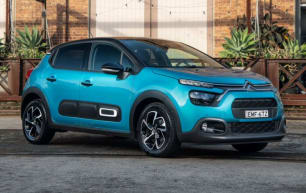At a fraction under 4.0m long, just over 1.8m wide, and close to 1.5m tall, the C3 is a small hatch that, in terms of practicality, does well in some areas and could do better in others.
On the plus side, there’s plenty of space for the driver and front seat passenger, and rear room is surprisingly generous. Sitting behind the driver’s seat, set for my 183cm position, I had more than adequate head, leg and knee room.
Three full-size adults across the rear is a short-journey proposition only, but a trio of up to mid-teenage kids will be fine.
The space-efficiency carries over to the boot, with 300 litres of volume available (below the parcel shelf) with the 60/40 split-folding rear seat upright. But beyond that number, the space has been carefully sculpted to maximise usability.
We managed to fit our three-piece (36L, 95L, 124L) luggage set in there, with a small cheat of removing the divider, and could swap them out for the bulky CarsGuide pram, with room to spare. Fold the rear backrest down and available space increases to an impressive 922 litres.
The downside is storage and concessions to comfort elsewhere in the car. As in, a lack of them.
For a start, the dual cupholders in the front centre console confirm the French’s affection for Espresso. You’ll struggle to locate an average size take-away coffee cup in one of those dainty receptacles.
The front door bins are long but relatively narrow, and lack a designated spot to hold bottles upright, so I found myself laying drink bottles horizontally along them, which is awkward.
Plus, there’s no lidded storage box between the front seats, so no centre armrest, either. Rather an open tray behind the handbrake lever.
The glove box is modest, there’s a small open cubby below the central multimedia screen that isn’t big enough to hold a phone, there’s just one USB-A port for connectivity/power and a single 12V outlet.
No fold-down centre armrest in the rear, either. There are map pockets on the front seat backs, a single (again, small) cupholder at the end of the front centre console for back-seaters to share, and while rear door pockets are welcome, they’re petite.
Yes, the boot is commodious, but it lacks tie-down anchors to secure loose loads, and the flimsy carpet in there is prone to moving around.
On a more positive note, the spare is a 15-inch space-saver, which is streets ahead of the all-too common inflator/repair kit.
















































